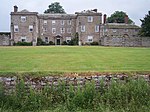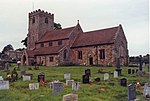Morville, Shropshire
Civil parishes in ShropshireShropshire geography stubsVillages in Shropshire

Morville is a village and civil parish about 3 miles west of Bridgnorth, in the Shropshire district, in the county of Shropshire, England. In 2011, the parish had a population of 392. The parish touches Acton Round, Astley Abbotts, Aston Eyre, Barrow, Bridgnorth, Chetton, Tasley and Upton Cressett.
Excerpt from the Wikipedia article Morville, Shropshire (License: CC BY-SA 3.0, Authors, Images).Morville, Shropshire
Ludlow Road,
Geographical coordinates (GPS) Address Nearby Places Show on map
Geographical coordinates (GPS)
| Latitude | Longitude |
|---|---|
| N 52.544035 ° | E -2.4896714 ° |
Address
Morville Barn
Ludlow Road 1,2
WV16 5NS
England, United Kingdom
Open on Google Maps










